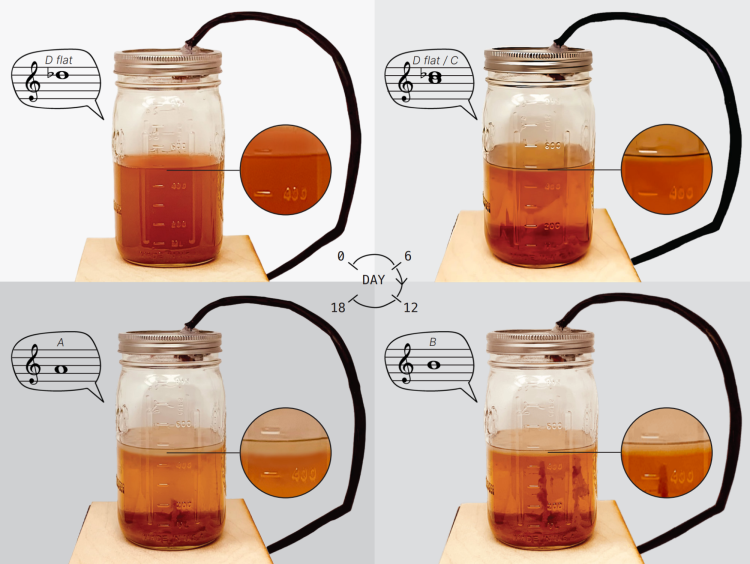Microbiology as meditation: Living Matter Lab explores “livingness” in time
For millennia, scientists, engineers, philosophers and artists have pondered time. What is it? How do we measure it? How does it impact our sense of reality?
The Living Matter Lab at the ATLAS Institute considers these questions through the lens of microbiology and the emerging field of biological human-computer interaction, which combines living materials and digital technologies. By interfacing with microscopic organisms, we can better understand how different forms of life experience time and how we might rethink our human-centric perspective on this concept.
The ATLAS Institute champions radical creativity and invention by pushing the boundaries of multidisciplinary study. As such, Living Matter Lab director and assistant professor, Mirela Alistar, PhD, and her lab members deploy computer science, nanotechnology, microbiology, genetics, social science and art in pursuit of a deeper understanding of alternative perspectives on temporality. Alistar explains, “My fascination with living organisms stems from livingness as a shared experience, the ‘bios’ (life in Greek) we all share.”
Observing SCOBY time
Temporality can be thought of as our relationship to time, but it is more nuanced than that. Oxford Reference notes: “In contrast to the measurable and calculated notion of time/chronology, temporality is concerned with the way in which a sequence of events, a kind of history, is physically experienced by those who live through them or experience them.”
Alistar’s approach to temporality considers how, for example, kombucha SCOBY (Symbiotic Culture of Bacteria and Yeast that lives in and ferments a tea medium) experiences time. Bacterial growth is a unique means for exploring multisensory measures of temporality in that it is possible to see, hear, smell and touch how the SCOBY develops over many days.
The Living Matter Lab team tracked ongoing changes in a kombucha SCOBY’s health and growth via sensors. Each day, the research team recorded observations, noting how biofilm developed and thickened on top while sediment collected on the bottom as the liquid medium lightened in color.

The sounds of temporality
This is where the research takes a surprising turn. At the time, Alistar was also working to engage the Boulder creative community with the SynthUX International Synth Design Hackathon. As a home to multi-disciplinary technical and creative talent, ATLAS is the perfect place to connect designers, engineers, artists and musicians together to explore new ways to make and manipulate sound—while competing with teams across the globe.
Though designers have created synthesizers played by natural elements (e.g., using wind, water or sunlight to trigger audio signals), Alistar saw a chance to take it further. “I was determined to have a non-human organism play the instrument live, while it is growing. Since the hackathon kit contained a photoresistor that measures light intensity, and SCOBY creates a layer that obstructs light, I put those together and designed a synthesizer.”
Bio-digital Calendar: engaging with non-human temporalities for multispecies understanding
Originally meant to produce musical tones, the prototype evolved to become a means to synesthetically measure time via light and through sound. Alistar dubbed it a “bio-digital calendar." She says, “it’s an imperfect name, but I had to call it something,” noting that although it is not quite equivalent, the project most closely resembles a calendar.
By translating the subtle changes in light passing through the SCOBY biofilm into corresponding sounds, the synthesizer adds a more pronounced marker to the subtle visual variations one could organically observe in the SCOBY over time. This became a process of “engaging with the organism as a means to incite humans toward recognizing and attuning toward nonhuman temporalities.” In other words, we get to experience microbiological time in terms humans can understand.
This multi-sensory approach to observe how another species experiences time decouples us from the way humans experience time as measured by Earth’s rotation. This allows us to sense different time scales and engender a greater appreciation for (relative) slowless beyond the static beat of a clock’s secondhand.

Layers of understanding
Alistar relates, “The transformative power of research is undeniable. For example, when listening to the livingness of non-human organisms, I end up making a bio-calendar and writing a research paper. However, I get way more than that: I learn more about life. That knowledge is not just a simple byproduct of my research. That knowledge has recursive impact: it transforms me in fundamental ways.”
The team recently presented their findings at TEI2024 (The ACM International Conference on Tangible, Embedded and Embodied Interaction) in Cork, Ireland, and was awarded Best Pictorial for their efforts.
Alistar and her research group believe this research could lead to the design of bio-digital artifacts made from different types of organisms to encourage humans to engage with other lifeforms more deeply. “When I think of the future, I imagine computing interfaces that can biodegrade and personal laboratories that can democratize healthcare. Taking an open-source and collaborative approach, I seek to build a broad community that can actively contribute to research. I am constantly exploring more inclusive and democratic models for innovation.”
For more details on this project:
Fiona Bell, Joshua Coffie, and Mirela Alistar. 2024. "Bio-Digital Calendar: Attuning to Nonhuman Temporalities for Multispecies Understanding". In: Proceedings of the Eighteenth International Conference on Tangible, Embedded, and Embodied Interaction (TEI '24). (New York, NY, February 11, 2024).


